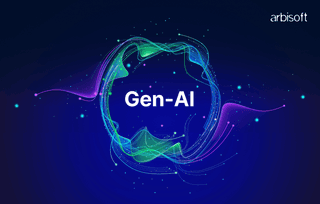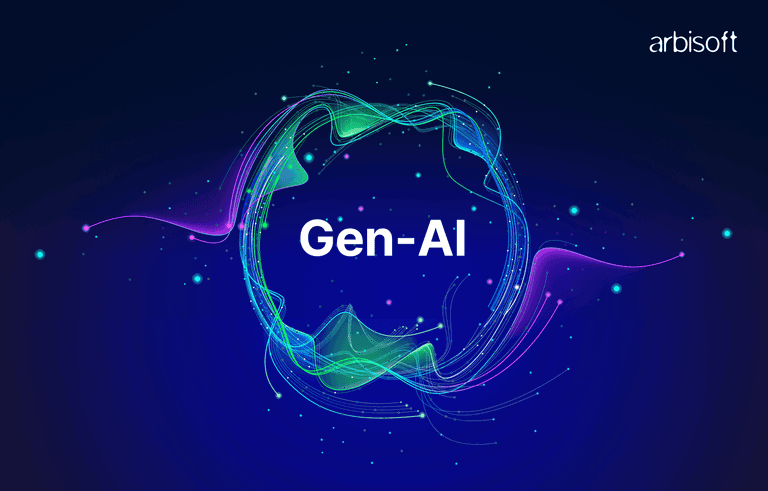We put excellence, value and quality above all - and it shows




A Technology Partnership That Goes Beyond Code

“Arbisoft has been my most trusted technology partner for now over 15 years. Arbisoft has very unique methods of recruiting and training, and the results demonstrate that. They have great teams, great positive attitudes and great communication.”
The Data Maturity Ladder Why Few Reach the Top & How You Can

92% of organizations say they're data-driven, but less than 18% actually have the advanced data capabilities that create real competitive advantage. That's a pretty big gap, right?
Before you dismiss this as another consultant's stat designed to sell services, ask yourself these questions:
Data Foundations & Quality
- Do you have clear, consistent definitions for key business terms like "active user" or "churn" that everyone actually uses?
- Are you actively tracking data quality metric accuracy, completeness, timeliness, or just assuming your data is good?
- When different systems show conflicting numbers, do you have a real process to figure out what's right?
Access & Usability
- Can business users get the data they need without submitting IT tickets or waiting for analysts?
- Do you have a data catalog or some way for people to discover what data exists and what it means?
- Are your dashboards standardized, or does every department create its own version of the same metrics?
Governance & Security
- Do you have clear policies for data access, privacy, and compliance that people actually follow?
- Are your data stewards held accountable for data quality in their performance reviews?
- Do you regularly check who's accessing sensitive data, or just trust that permissions are set correctly?
Analytics & Advanced Use
- Are you using predictive analytics to forecast what might happen, not just reporting what has already happened?
- If you have ML models, are they actually running in production and helping with real decisions?
- Do business teams trust your models enough to make important decisions based on their outputs?
Culture & Strategy
- Do your executives look at data first when making decisions, or check the numbers after going with their gut?
- Is there an actual budget allocated to improving data capabilities, people, and processes, not just tools?
- Does your organization celebrate and share stories about how data drove better outcomes?
If you answered "no" to most of these, you're likely at Stage 1 of data maturity. Mixed answers indicate Stage 2, and consistent "yes" answers point to Stage 3. Most organizations are surprised to find themselves much earlier in their journey than they thought.
The truth is, most leaders think having some dashboards and a business intelligence tool means they're data-driven. You will see this all the time, executives proudly showing off their colorful charts while their teams are still spending 80% of their time hunting down data instead of analyzing it.
What Data Maturity Actually Means
Real data maturity isn't about buying the latest tool or having the most data. It's about how reliably your organization turns data into trustworthy decisions that actually matter.
It's about having the systems, people, and culture in place to make data work for you, not against you. When you're truly data-mature, your team stops asking "Where did this number come from?" and starts asking "What should we do about it?"
The Problem with Most Data Maturity Models
If we look at tons of data maturity frameworks introduced over the years, honestly, most of them fall into two camps that struggle to be practically helpful:
- The oversimplified ones that basically say "collect data, analyze data, use data," which ignore how complex organizations actually are
- The academic monsters with 47 different dimensions and subcategories that look great in PowerPoint but are impossible to actually use
What I've found works better is thinking about data maturity as three distinct stages that actually reflect how organizations evolve in the real world. But here's the key thing most models miss: you don't progress linearly through these stages. Different parts of your organization might be at different levels, and that's completely normal.
Stage 1: The Firefighting Phase
Let's start with Stage 1, which I prefer to call the "firefighting phase" because that's exactly what it feels like. If you're in Stage 1, data problems feel like they come out of nowhere, and you're constantly struggling to fix them.
What Stage 1 Actually Looks Like
Your marketing team has its customer data in Salesforce, your operations team tracks everything in spreadsheets, and your finance team has its own ERP system. When someone asks for a "simple" report combining customer acquisition costs with operational efficiency, it takes three weeks and involves at least five people arguing about whose numbers are "right."
In Stage 1, nobody really owns the data. Marketing thinks customer data is theirs, sales have their own version of the same customers, and when discrepancies show up, everyone points fingers. IT becomes the bottleneck for everything because they're the only ones who can actually access multiple systems.
The Real Problems in Stage 1
The biggest issue isn't technical; it's that everyone treats data like it belongs to their department. This creates what I call "data territory," where each team protects its information and uses its own definitions for everything.
Imagine a scenario I encountered once, at a healthcare provider, where the term “patient” meant something different across departments. The billing team counted anyone who had ever received an invoice, clinical staff only included those with an active treatment plan, while the outreach team counted every person who had attended a wellness seminar. Now imagine trying to calculate patient retention or treatment outcomes when no one even agrees on who qualifies as a patient.
Quick Reality Check
You're probably in Stage 1 if:
- Data quality issues require calling meetings to figure out whose fault it is
- Business users regularly ask IT to export data to Excel so they can "do their own analysis"
- The same metrics mean different things in different reports
- Preparing for executive meetings means spending days reconciling numbers from different systems
Stage 2: Putting Structure in Place
Stage 2 is where organizations start to get serious about data. This is the "Putting Structure in Place" phase, and it's honestly where most of the hard work happens.
What Changes in Stage 2
The biggest shift is that data stops being IT's problem and becomes everyone's opportunity. You start seeing things like data governance committees (that actually meet), clear ownership of data assets, and a crucial thing: executives who understand that good data requires investment.
In Stage 2, you're building the infrastructure that should have been there all along. This means integrating systems, standardizing definitions, and creating processes that prevent problems instead of just fixing them after they happen.
The Infrastructure Wake-Up Call
Here's what I see happen in Stage 2: organizations realize their data infrastructure is like a house built without a foundation. Sure, it's standing, but it's not stable. So they invest in integration platforms, modern data warehouses, and tools that actually talk to each other.
But the technical stuff is only half the story. The other half is cultural. In Stage 2, business users start taking responsibility for data quality instead of just complaining about it. Data stewards come up who actually understand both the business and the technical side of data.
Where Stage 2 Gets Interesting
The analytics capabilities in Stage 2 go beyond "what happened last month" reporting. You start seeing predictive analytics that actually influence decisions. Instead of just tracking customer churn after it happens, you're identifying customers at risk and doing something about it.
I've noticed different industries progress through Stage 2 in different ways. Financial services companies usually get there through risk management, and regulatory requirements force them to get serious about data governance, which then enables better analytics. Healthcare organizations often progress through population health initiatives that require integrating clinical and operational data.
Stage 2 Reality Check
You know you're in Stage 2 when:
- Data quality issues get caught and fixed automatically
- Business users can get the data they need without calling IT
- Your metrics are consistent across departments
- You're making some decisions based on predictions, not just historical trends
Stage 3: Data as a Strategic Asset
Stage 3 is where data becomes truly strategic. This isn't just about having good analytics; it's about data being so embedded in how you operate that you can't imagine running the business any other way.
What Stage 3 Really Means
In Stage 3 organizations, data strategy and business strategy are the same thing. When they're planning new products, data insights drive the decision. When they're optimizing operations, they're using real-time data to make continuous improvements. When they're thinking about partnerships, they're considering how data can create network effects.
The technology in Stage 3 is sophisticated; we're talking AI and machine learning that's actually integrated into business processes, not just sitting in a lab somewhere. But the real difference is cultural. Everyone in the organization thinks about data as naturally as they think about customers or finances.
AI and Advanced Analytics Done Right
Here's where Stage 3 gets really interesting: the AI isn't just analyzing data, it's helping manage the data itself. You've got systems that automatically detect and fix quality issues, algorithms that optimize data storage and processing, and machine learning models that continuously improve business processes.
But, and this is important, the AI is augmenting human decision-making, not replacing it. The best Stage 3 organizations you will see use AI to give their people superpowers, not to eliminate people entirely.
Beyond Your Organization's Walls
Stage 3 organizations think about data ecosystems, not just internal data. They're sharing data with partners in ways that create value for everyone, they're monetizing data products, and they're participating in industry data networks that give them competitive advantages.
Stage 3 Reality Check
You're probably in Stage 3 if:
- Your business strategy discussions naturally include data implications
- You're using AI for business process optimization, not just analytics
- Your data capabilities are a source of competitive advantage
- You're creating new revenue streams from your data assets
The Practical Reality of Moving Forward
Now, let me share what I've learned about actually advancing through these stages, because the theory is one thing and the reality is quite another.
It's Not Linear (And That's OK)
First, forget about moving neatly from Stage 1 to 2 to 3. Most organizations you'll work with will be Stage 2 in some areas and Stage 1 in others. Your customer analytics might be Stage 3 while your supply chain data is still firmly in Stage 1. This is normal and actually makes progression planning easier because you can focus on the areas that will give you the biggest business impact.
Start With What Matters Most
The biggest mistake I see organizations make is trying to fix everything at once. Pick the data domain that's most critical to your business success and focus there first. If you're a retail company, maybe that's customer data. If you're in manufacturing, it might be operational data from your production lines.
Quick Wins vs. Long-Term Foundation
You need both quick wins to maintain momentum and foundational investments that enable long-term success. A quick win might be cleaning up your customer database and creating better customer segmentation. A foundational investment might be implementing a proper data governance framework.
The trick is balancing these so you're showing progress while building for the future.
Culture Eats Strategy for Breakfast
Here's the thing nobody talks about enough: the biggest barriers to data maturity aren't technical; they're cultural. You can have the best technology in the world, but if people don't trust the data or don't know how to use it, you're not going anywhere.
This means investing in data literacy training, changing how you make decisions, and probably having some uncomfortable conversations about accountability and ownership.
What's Next for Data Maturity
Looking ahead, I see several trends that are changing how we think about data maturity:
- Real-Time Everything: The expectation for real-time insights and decision-making is becoming universal. Organizations need to think about data freshness and processing speed as competitive advantages
- AI Integration: AI is moving from "nice to have" to "must have" for data management itself. Organizations that don't integrate AI into their data operations will fall behind
- Data Products: More organizations are thinking about data as products with defined customers, service levels, and ownership. This product thinking is changing how data teams operate.
- Privacy and Ethics: With increasing regulation and consumer awareness, ethical data use isn't just about compliance; it's about maintaining trust and social license to operate.
The Path Forward
If you're thinking about where to start or how to accelerate your data maturity journey, here's my take on it.
- Use the reality checks I outlined to honestly assess where you are. Don't be generous with yourself; it's better to start with a realistic view than an optimistic one.
- Choose one or two areas where advancement will have the biggest business impact and focus there first.
- Data maturity initiatives fail without sustained executive support. Make sure leadership understands both the investment required and the business value expected.
- Plan for quick wins that demonstrate progress while making the foundational investments that enable long-term success.
- Technology is important, but people make the difference. Invest in training, change management, and creating a culture that values data-driven decision-making.
We're using Databricks at Arbisoft as we transition from basic data collection to actually getting strategic value from our data. Having everything in one platform, analytics, governance, and ML capabilities, is helping us move faster than we could with our old patchwork of tools. We're not there yet, but we can see how this unified approach is going to transform our data usage to drive business decisions.
To Sum It Up
Data maturity isn't about reaching some final destination; it's about continuously improving your organization's ability to create value from data. The organizations that master this continuous improvement approach will create sustainable competitive advantages in our increasingly data-driven world.
The good news is that every organization can advance its data maturity, regardless of where it's starting from. The key is being honest about where you are, focusing on what matters most to your business, and committing to the journey.
Because here's what I know for sure, in 5 years, the gap between data-mature organizations and everyone else is only going to get wider. The question is which side of that gap you want to be on.
























